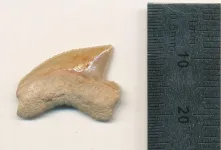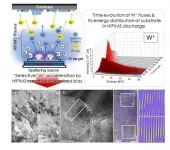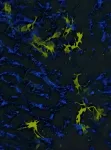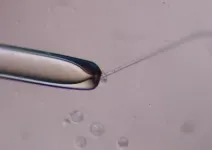The City of David and the sharks' teeth mystery
2021-07-04
(Press-News.org) Scientists have found an unexplained cache of fossilised shark teeth in an area where there should be none - in a 2900 year old site in the City of David in Jerusalem. This is at least 80 km from where these fossils would be expected to be found. There is no conclusive proof of why the cache was assembled, but it may be that the 80 million-year-old teeth were part of a collection, dating from just after the death of King Solomon*. The same team has now unearthed similar unexplained finds in other parts of ancient Judea.
Presenting the work at the Goldschmidt Conference, lead researcher, Dr. Thomas Tuetken (University of Mainz, Institute of Geosciences) said:
"These fossils are not in their original setting, so they have been moved. They were probably valuable to someone; we just don't know why, or why similar items have been found in more than one place in Israel".
The teeth were found buried in material used to fill in a basement before conversion to a large Iron-Age house. The house itself was situated in the City of David, one of the oldest parts of Jerusalem, found nowadays in the largely Palestinian village of Silwan. They were found together with fish bones thrown away as food waste 2900 years ago, and other infill material such as pottery. Intriguingly, they were found together with hundreds of bullae - items used to seal confidential letters and packages - implying a possible connection with the administrative or governing class at some point. Normally archaeological material is dated according to the circumstances where it is found, and so at first it was assumed that the teeth were contemporary with the rest of the find. Dr. Tuetken said:
"We had at first assumed that the shark teeth were remains of the food dumped nearly 3000 years ago, but when we submitted a paper for publication, one of the reviewers pointed out that the one of the teeth could only have come from a Late Cretaceous shark that had been extinct for at least 66 million years. That sent us back to the samples, where measuring organic matter, elemental composition, and the crystallinity of the teeth confirmed that indeed all shark teeth were fossils. Their strontium isotope composition indicates an age of about 80 million years. This confirmed that all 29 shark teeth found in the City of David were Late Cretaceous fossils - contemporary with dinosaurs. More than that, they were not simply weathered out of the bedrock beneath the site, but were probably transported from afar, possibly from the Negev, at least 80 km away, where similar fossils are found".
Since the first finds, the team have found other shark teeth fossils elsewhere in Israel, at the Maresha and Miqne sites. These teeth are also likely to have been unearthed and moved from their original sites.
Dr. Tuetken said:
"Our working hypothesis is that the teeth were brought together by collectors, but we don't have anything to confirm that. There are no wear marks which might show that they were used as tools, and no drill holes to indicate that they may have been jewellery. We know that there is a market for shark's teeth even today, so it may be that there was an Iron Age trend for collecting such items. This was a period of riches in the Judean Court. However, it's too easy to put 2 and 2 together to make 5. We'll probably never really be sure".
The shark teeth which have been identified come from several species, including from the extinct Late Cretaceous group Squalicorax. Squalicorax, which grew to between 2 and 5 metres long, lived only during the Late Cretaceous period (which was the same period as the late dinosaurs), so acts as a reference point in dating these fossils.
Commenting, Dr. Brooke Crowley (University of Cincinnati) said:
"This research by Dr. Tuetken and colleagues is an excellent example of why it is so important to approach a research question with as few assumptions as possible, and how sometimes we have to revisit our initial assumptions. It also highlights how beneficial it can be to apply multiple tools to answer a research question. In this case, the authors used both strontium and oxygen isotopes, as well as x-ray diffraction and trace element analysis to establish most likely age and origin of the fossil teeth. It was a monumental of work but these efforts have revealed a much more interesting story about the people who lived in this region in the past. I am very excited by this work and hope that one day, we might be able to unravel the mystery of why these fossil teeth are being recovered from cultural deposits".
INFORMATION:
Dr. Crowley was not involved in this work. The work relating to the Jerusalem finds has been published in the peer-reviewed journal Frontiers in Ecology and Evolution 8:570032 (https://doi.org/10.3389/fevo.2020.570032), Dr. Crowley edited this paper for the journal. This press release contains additional material not mentioned in the publication.
Notes
This work is presented on 6th July, but is being released to the press early.
*The find dates from the time of the immediate descendants of King Solomon; Rehoboam, Abija, Assa, and Jehoshapat.
The Goldschmidt Conference is the World's main geochemistry conference. It is hosted alternately by the European Association of Geochemistry (Europe) and the Geochemical Society (USA). The 2021 conference (virtual) takes place from 4-9 July, https://2021.goldschmidt.info/. The 2022 conference takes place in Hawaii.
[Attachments] See images for this press release:

ELSE PRESS RELEASES FROM THIS DATE:
2021-07-03
Tokyo, Japan - Researchers from Tokyo Metropolitan University have used high power impulse magnetron scattering (HiPIMS) to create thin films of tungsten with unprecedentedly low levels of film stress. By optimizing the timing of a "substrate bias pulse" with microsecond precision, they minimized impurities and defects to form crystalline films with stresses as low as 0.03 GPa, similar to those achieved through annealing. Their work promises efficient pathways for creating metallic films for the electronics industry.
Modern electronics relies on the intricate, nanoscale deposition of thin metallic films onto surfaces. This is easier said than done; unless done right, "film stresses" arising from the microscopic internal structure of the film ...
2021-07-02
In recent years, immunotherapy has revolutionised the field of cancer treatment. However, inflammatory reactions in healthy tissues frequently trigger side effects that can be serious and lead to the permanent discontinuation of treatment. This toxicity is still poorly understood and is a major obstacle to the use of immunotherapy. Scientists from the University of Geneva (UNIGE), Switzerland, and Harvard Medical School, United States, have succeeded in establishing the differences between deleterious immune reactions and those targeting tumour cells that are sought after. It appears that while the immune mechanisms are similar, the cell ...
2021-07-02
It is the membrane of cancer cells that is at the focus of the new research now showing a completely new way in which cancer cells can repair the damage that can otherwise kill them.
In both normal cells and cancer cells, the cell membrane acts as the skin of the cells. And damage to the membrane can be life threatening. The interior of cells is fluid, and if a hole is made in the membrane, the cell simply floats out and dies - a bit like a hole in a water balloon.
Therefore, damage to the cell membrane must be repaired quickly, and now research from a team of Danish researchers shows that cancer cells use a ...
2021-07-02
Fast facts:
Nanobodies have been shown to inhibit the dysfunction of key proteins involved with various diseases such as rheumatoid arthritis, osteoarthritis, psoriasis, B-cell lymphoma, and breast cancer
Understanding the structure of a nanobody helps to better understand its disease-fighting potential
Typically, the protein structure is determined from solid samples. Researchers at NYUAD used a liquid state technique to determine protein structure.
Abu Dhabi, UAE: For the first time in the UAE, researchers at NYU Abu Dhabi have used ...
2021-07-02
For decades, people have wondered why pelagic red crabs--also called tuna crabs--sometimes wash ashore in the millions on the West Coast of the United States. New research shows that atypical currents, rather than abnormal temperatures, likely bring them up from their home range off Baja California.
Alongside the discovery, the scientists also created a seawater flow index that could help researchers and managers detect abnormal current years.
The new study, published July 1 in Limnology and Oceanography, began after lead author Megan Cimino biked past a pelagic red crab stranding on her way to her office in Monterey ...
2021-07-02
East Hanover, NJ. July 2, 2021. Among wheelchair users with spinal cord injury 42 percent reported adverse consequences related to needing wheelchair repair, according to a team of experts in spinal cord injury rehabilitation. The research team, comprised of investigators from the Spinal Cord Injury Model System, determined that this ongoing problem requires action such as higher standards of wheelchair performance, access to faster repair service, and enhanced user training on wheelchair maintenance and repair.
The article, "Factors Influencing Incidence of Wheelchair Repairs and Consequences Among Individuals with Spinal Cord Injury" (doi: 10.1016/j.apmr.2021.01.094) was published online in ...
2021-07-02
BOSTON -- Gaurav Gaiha, MD, DPhil, a member of the Ragon Institute of MGH, MIT and Harvard, studies HIV, one of the fastest-mutating viruses known to humankind. But HIV's ability to mutate isn't unique among RNA viruses -- most viruses develop mutations, or changes in their genetic code, over time. If a virus is disease-causing, the right mutation can allow the virus to escape the immune response by changing the viral pieces the immune system uses to recognize the virus as a threat, pieces scientists call epitopes.
To combat HIV's high rate of mutation, Gaiha and Elizabeth Rossin, MD, PhD, a Retina Fellow at Massachusetts Eye and Ear, a member of Mass General ...
2021-07-02
BUFFALO, N.Y. -- A year after University at Buffalo scientists demonstrated that it was possible to produce millions of mature human cells in a mouse embryo, they have published a detailed description of the method so that other laboratories can do it, too.
The ability to produce millions of mature human cells in a living organism, called a chimera, which contains the cells of two species, is critical if the ultimate promise of stem cells to treat or cure human disease is to be realized. But to produce those mature cells, human primed stem cells must be converted back into an earlier, less developed naive state so ...
2021-07-02
When environmental physicist Kira Rehfeld, from Heidelberg University, visited Antarctica for her research, she was struck by the intense light there. "It's always light in summer. This solar radiation could actually be used to supply the research infrastructure with energy", she observes. However, generators, engines, and heaters in these remote regions have mostly been powered until now by fossil fuels delivered by ship, such as petroleum or petrol, which cause global warming. Besides the high associated economic costs, pollution from even the smallest spills is also a major problem threatening the especially sensitive ...
2021-07-02
July 2, 2021 - For health care organizations looking to improve performance and patient experiences, implementing data-driven solutions can be effective when focusing on addressing health equity and reducing patient length of stay. These topics are explored in selected member-submitted abstracts from the 2020 Vizient® Connections Education Summit that appear in a special supplement to the July/August 2021 issue of the American Journal of Medical Quality, the official journal of the American College of Medical Quality (ACMQ).
Interventions for addressing health equity
To help health care organizations address ...
LAST 30 PRESS RELEASES:
[Press-News.org] The City of David and the sharks' teeth mystery






